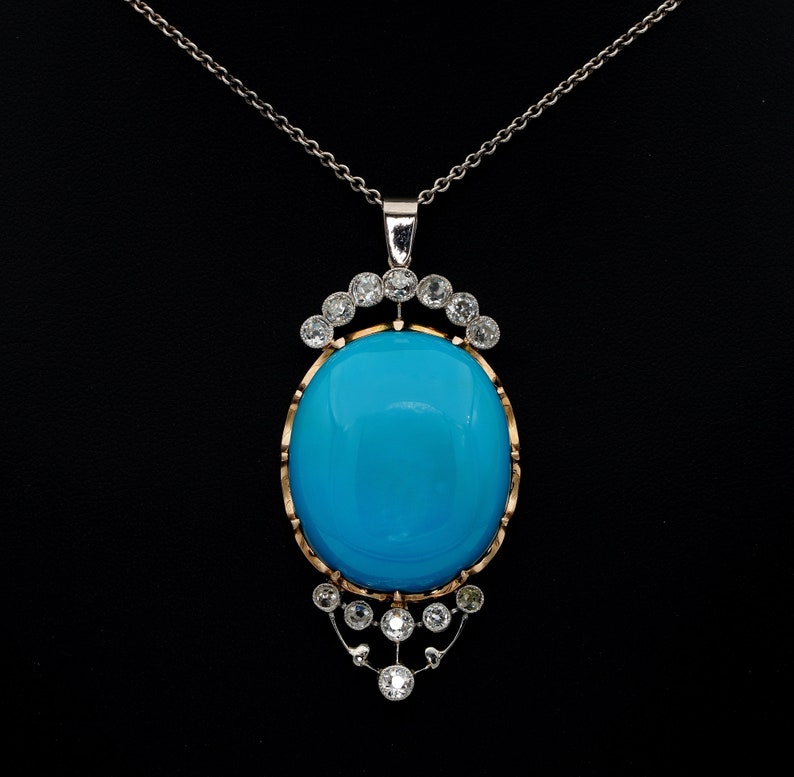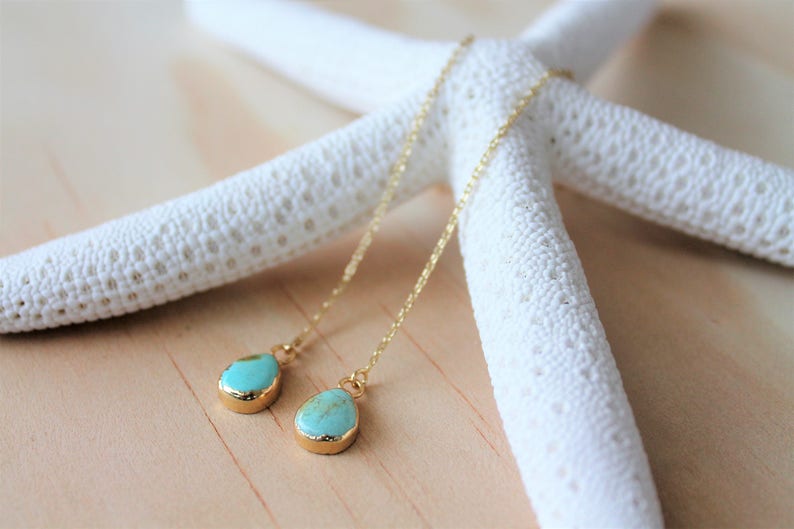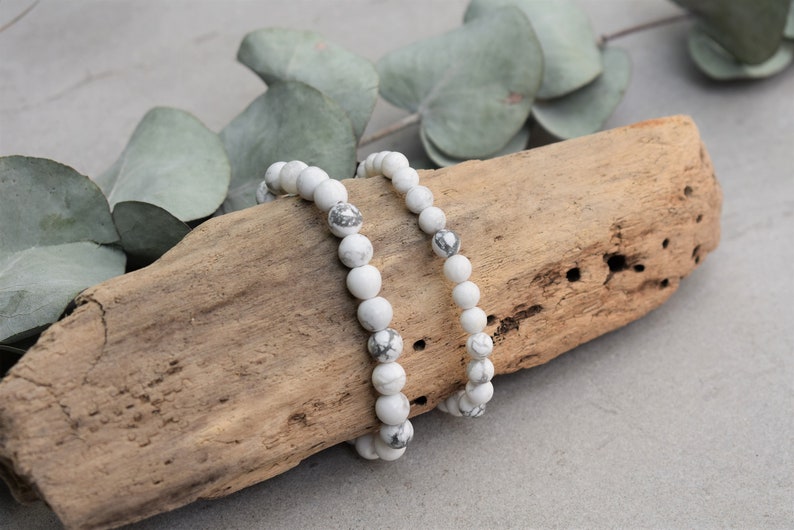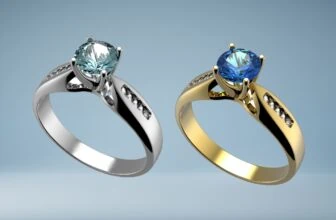
Table of Contents
Turquoise is one of the most popular semi-precious stones used in jewelry. This beautiful stone with its intriguing hue is one of the few gemstones with a color named after it. Though it isn’t anywhere near as expensive as a diamond or sapphire, turquoise has no less a magical effect than these expensive stones.
In this comprehensive shopping guide, we’ll walk you through our top tips for buying the perfect turquoise gemstone.

What Is Turquoise?

Turquoise is an opaque mineral with a beautiful greenish-blue hue. The name ‘turquoise’ is derived from the French word for Turkish, because the stone was first brought to Europe from Turkey. Excavated from mines in Asia, turquoise gemstones journeyed along trade routes that passed through Turkey. Hence, Turkish stone.
Turquoise forms over millions of years, occurring when water oozes through rocks that contain certain minerals, such as copper and aluminum. When this happens, a chemical reaction is set off and veins are formed, which later bunch together creating turquoise.
What Are Turquoise Varieties?
Turquoise varieties are generally known by the location where they were found. Each of these varieties have distinguishing factors. For example, Persian turquoise (فیروزه) is not as porous as other types and so has a better polish, while American and Mexican varieties are quite porous and have lighter green-blue colors.
A common variety that is found widely is turquoise matrix. This refers to turquoise containing parts of the host rock, like this turquoise cuff bracelet. If the matrix is included, this means that it contains the vein-like inclusions so often found on turquoise.
Choosing Turquoise Color

In terms of value, color and saturation are critical factors of turquoise. Although the word turquoise evokes a certain color in mind, there are several shades of blue and green under this umbrella.
You can find turquoise ranging from light sky blue, mid-range blues, deep blue, blue-green, vivid green, sea green to leaf green.
Evenly distributed, intense, medium blue color turquoise, like this pendant, is the most sought-after variety. It’s also known as Persian blue in the industry and is the most valuable type of turquoise.
Choosing Turquoise Cut

Turquoise is quite versatile and can be cut into various shapes, the most popular of which are cabochons, ovals, beads, and chips. Most turquoise is kept smooth to highlight its color and texture.
Because turquoise is naturally very beautiful, cutting is not a critical factor to bring out its beauty. Turquoise is sometimes faceted or used in its rough form depending on the style of the piece of jewelry.
Choosing Turquoise Clarity
Turquoise is generally opaque, although you can find translucent turquoise as well. Typically, the stone has a matte appearance with little brilliance. Most turquoise contains matrix – the dark spidery inclusions ranging from dense to light.
Although shoppers generally prefer clear and glossy turquoise free of any inclusions, turquoise with inclusions can have intriguing designs that make it attractive.
Choosing Turquoise Size
Turquoise is often mined in large slabs and then is broken into smaller chunks for jewelry. You can find it in a variety of sizes, although stones of about 4-8 carats usually work well for jewelry.
Larger stones would be more favorable for ornamental pieces. The price for turquoise varies but averages around $30 to $40 per carat for a gemstone quality piece.
Choosing Turquoise Jewelry

Turquoise is an ideal stone for a chic, classic look. It best suits cool skin tones but even warm tones can pull it off. Of course, it’s important to ensure that the stone you choose complements the rest of the outfit.
Luckily, turquoise is a versatile colored gemstone and goes well with many other colors. It best complements neutrals, like brown, black, white, grey, and nudes. For a striking contrast, pair it with warm colors.
Choose minimalist turquoise jewelry pieces to tone down the look for casual or office wear. If you want to glam up a minimal outfit, then a statement piece of turquoise jewelry will really stand out.

Yellow or rose gold adds a classy, vintage touch to turquoise jewelry, while white metals give it a modern look.
Turquoise makes excellent eternity rings and can work as wedding rings too. They’re also an excellent choice for promise rings because in many traditions, giving a turquoise ring means ‘forget me not’.
How to Care for Turquoise Jewelry
Turquoise is a fairly soft gemstone with a ranking of 5-6 on the Mohs hardness scale. What this means is that other stones that are harder than turquoise can damage it when they come in contact in a harsh manner. If turquoise is stored together with harder stones such as diamonds, they are more prone to damage.
The outer surface of turquoise is very permeable, meaning that it can absorb liquids or gases it encounters. Wearing turquoise jewelry while doing household chores such as cleaning with harsh chemicals, using soaps, harsh shampoos or applying makeup, can sometimes permanently damage it. Even chlorine in the swimming pool can discolor turquoise. Make sure you remove all pieces of turquoise jewelry when doing these activities.
Wiping the surface of the stone with a cloth dipped in hot water is the ideal method for cleaning turquoise. However, wipe it immediately after washing. The use of any kind of soaps isn’t recommended since soaps contain oils that can damage the stone. Never clean turquoise using an ultrasonic cleaner.
Be Aware of Turquoise Imitations
Modern technology has helped in inventing many chemical formulas that create a final product similar to turquoise. These synthetic imitations come cheap and seldom have the effect the original stone gives. There are also many natural minerals that look like turquoise. For example, variscite can be confused with turquoise, although it is greener in appearance.
The most prevalent imitation today is colored howlite, like this tree of life pendant. Howlite is a greyish white mineral that looks very similar to turquoise when dyed. Unscrupulous vendors sometimes sell howlite not under the faux turquoise label but instead as white turquoise, a rare form of turquoise that mainly comes from Arizona and Nevada.
Howlite vs. Turquoise – Differences

Here are some ways that you can check if the stone you hold in your hand is a true turquoise or a fake.
- Price:
If it seems too good to be true, then the dealer is probably ripping you off. Imitations always come at a cheaper price and real turquoise can be very valuable.
- Saturation:
Check the saturation of the stone. The inside of the stone should be blue through and through. If it is white, then it is most probably howlite as the dye used to turn howlite into turquoise does not penetrate beneath the surface.
Wipe the stone with some nail polish and a cotton bud. If the cotton bud becomes blue and the stone in that patch turns lighter, you know that the stone is a dyed howlite.
- Hardness:
Howlite has a Mohs ranking of approximately 3.5, making it softer than turquoise. If your stone scratches easily, it may very well be a fake.
Turquoise Treatments and Enhancements
While high-quality turquoise is durable and beautiful in appearance, medium to low grade stones require some enhancements to stabilize their surface and enhance their appearance.
The most common method of enhancement is called the Zachary Process. This improves the surface texture of the stone, allowing it to be easily polished, and may also improve the color of the turquoise.
Some other enhancements include stabilized turquoise, plastic turquoise, dyed turquoise, and infused turquoise.
Some people don’t prefer stabilized turquoise since they believe it to be artificially dyed stones or somehow fake. However, even high-grade turquoise sometimes needs stabilization. It is a necessary process to evenly saturate the stone and enhance durability.
Turquoise Meaning and Symbolism
Turquoise is one of the birthstones for December, along with zircon and tanzanite. Turquoise jewelry makes excellent gifts for a December born baby.
Turquoise is valued as a stone with protective and healing properties. It represents tranquility, wisdom, hope, and good luck.
It was believed that turquoise stones indicated the health of the wearer. It was believed that these stones would emit a pale blue color if the owner of the stone was sick and would entirely loses its color if the person died. But the stone regains its former glory when the ownership transfers and changes according to the health condition of the new owner.
Turquoise has been valued by cultures around the world, including Persians, Chinese, Native Americans and Egyptians who regarded turquoise as sacred and believed that wearing the stone would bring unusual luck as well as power to the wearer.
Some cultures also believe that turquoise can help communicate with the spirits and turn fortunes in one’s favor.
*Disclaimer: Jewelry Shopping Guide does not guarantee or validate any of the claims related to the metaphysical and alternative healing powers of this or any other gemstone. This information should in no way be used as a substitute for medical advice.
Where to Buy Turquoise Jewelry
Turquoise is a popular gemstone, so it’s not difficult to find your ideal piece at the local jewelers. Because it is the December birthstone, many retailers carry a good range of turquoise jewelry. When buying online, ensure that you are buying from a top-rated vendor with a proven track record.
- One of the most popular gemstone jewelry retailers online, Angara allows you to customize your jewelry and choose the quality of your gemstone. Highly reputable with rave customer reviews, Angara offers reasonable pricing and great after sales polices.
- Etsy: Etsy has an abundance of turquoise jewelry at a range of price points and to suit a variety of styles. You can even find vintage or antique pieces worth thousands. Each Etsy store has its own policies and rules, so make sure you check reviews and the after sales policies of the store before you purchase.
- Amazon: Amazon also provides an excellent variety of turquoise jewelry. As Amazon is a massive platform and offers everything, you’ll need to filter and sift through their inventory to find the right piece of turquoise jewelry for you.
Turquoise FAQs
What color is the best turquoise?
Turquoise with an evenly distributed medium blue hue is considered the best. This is called Persian blue.
Is turquoise rare?
Turquoise is one of the rarest gemstones in the world, but its price doesn’t reflect this rarity.
What is Sleeping Beauty turquoise?
This refers to a solid light blue turquoise hue with no visible dark veins (matrix). They come from Arizona.
Is turquoise jewelry out of style?
Turquoise jewelry is always in fashion, as it’s one of the most famous gemstones used in jewelry. Because it’s so versatile, it can be adapted to suit any style of jewelry.
Is turquoise good for engagement rings?
Turquoise is beautiful in engagement rings but can be too soft. They will need to be protected and given sufficient care.
What does turquoise represent?
Turquoise is a stone of protection and guidance.
Is turquoise unisex?
Turquoise is worn by both men and women.









